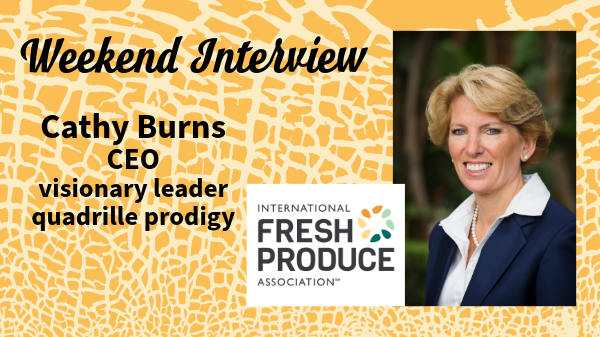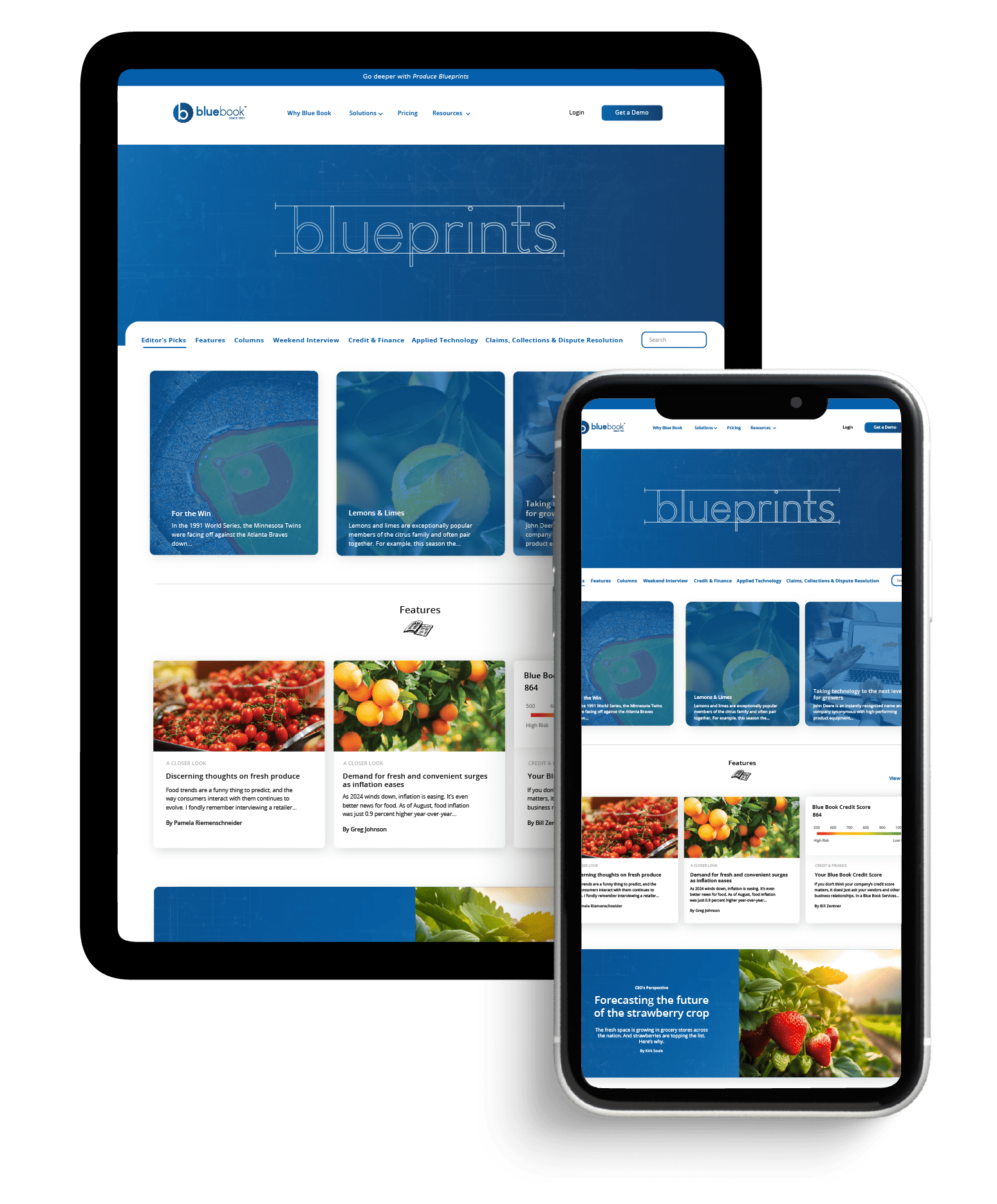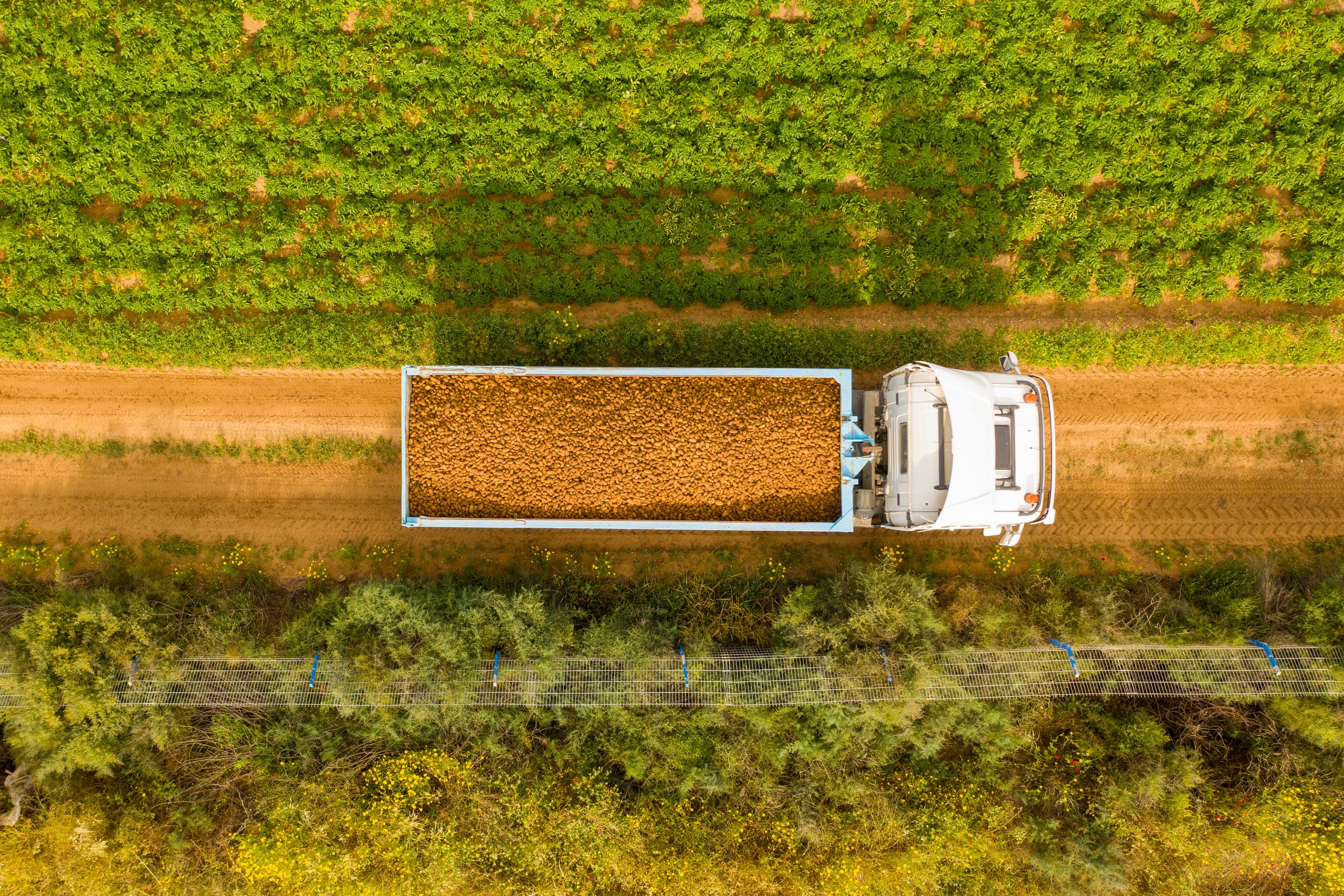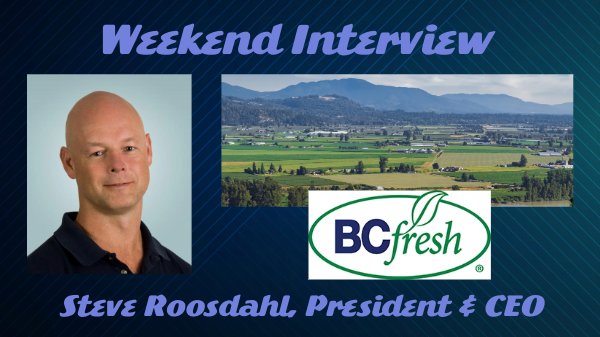Welcome to Blue Book!
Are you ready to join the thousands of companies who rely on Blue Book to drive smarter decisions? View our plans and get started today!
Still have questions? We’d love to show you what Blue Book can do for you. Drop us a line– we’ve been waiting for you.

Юрий Парменов/Adobe Stock
In this article
Cathy Burns’ journey from a grocery bagger in Bangor, Maine to the helm of a global produce association is both inspiring and deeply rooted in purpose.
She is a well-polished, engaging, and articulate leader. As CEO of the International Fresh Produce Association (IFPA) BB #:378962, she has become a powerful advocate for the role of fresh fruits, vegetables, and floral in public health, retail innovation, and everyday life.
While perhaps best known for her corporate accomplishments, Burns’ lights up when sharing stories about her roots. “I square danced for 13 years; I started at the age of 3 and I danced until I was 16. So while you all were watching cartoons on Saturday morning, I was square dancing.” She mentions being named “Queen of the Maypole” too, and notes, laughing, “I could probably still wrap a Maypole today.”
While seemingly unrelated, Burns credits these activities with instilling her with a sense of purpose, discipline, commitment, respect, and accountability—which have all underpinned her career and brought her to her position today.
Q: What inspired you to pursue a career in the grocery retail sector?
I started in the grocery industry as a bagger at Doug’s Shop ’n Save Supermarkets, affiliated with Hannaford. Believe it or not, you had to know someone to get a job bagging groceries back then! I worked through high school and college and really came to appreciate the complexity behind the scenes and the importance of the customer experience.
I actually thought I was going to work for Disney when I graduated. I wanted to help make people’s dreams come true. But over time, I realized you can do that regardless of what organization you work for—you just create the environment that allows others to thrive.
That’s what I found in my career at Hannaford and Food Lion. Helping people accomplish their dreams, both personally and professionally, became the most fulfilling part of my work.
Q: Why did you leave retail to lead the Produce Marketing Association (now IFPA)?
When my time at Food Lion came to a close, my husband and I took a weekend away. I created four guiding principles to help me decide what to do next; the opportunity with PMA checked every box.
I had gotten to know the organization through my work leading the produce traceability initiative when I was COO at Food Lion. So when they came knocking, it just made sense.
I joined PMA in 2013, became CEO in 2016, and then in 2021, I worked with United Fresh’s CEO, Tom Stenzel, to merge our organizations into what is now IFPA.
The truth is, both buyers and suppliers want the same thing: to drive consumption. It’s the how where things get tricky. And that’s where IFPA helps.
Q: How does IFPA help bridge the divide between buyers and suppliers?
We advocate, connect, and guide. And one of our biggest strengths is we represent the entire global supply chain, which means we can host conversations that are collaborative.
At IFPA, we exist to do what no single company can do on its own. We bring the entire supply chain together—from seed to retail and foodservice operators—and create spaces for these conversations through events like our Retail Conference and our Supply Chain of the Future initiative.
At our conferences around the world and through our volunteer leadership groups—our board, councils, committees—we create safe, transparent spaces for discussion. The truth is, both buyers and suppliers want the same thing: to drive consumption. It’s the how where things get tricky. And that’s where IFPA helps.
One of the things I’ve learned over 40 years is that cost is always part of the conversation—and probably always will be. But I’d encourage suppliers to go beyond the transactional. Really learn a retailer or foodservice operator’s go-to-market strategy and speak their language.
Ask yourself: how does your product enhance their brand, support their operations, or give them a point of differentiation? That’s where innovation and growth happen.
Q: How does the “Make America Healthy Again” (MAHA) movement align with the produce industry?
The goal is simple: make fresh produce central to our national health strategy. And you cannot be healthy without fruits and vegetables. Whenever health is at the center of a conversation, that’s good for our industry.
But we never want to leave things to chance. Earlier this spring, IFPA submitted seven evidence-based policy solutions to the MAHA Commission. These are: (1) embed produce prescriptions as a covered benefit within the health system; (2) enhance nutrition clarity in food labeling; (3) expand financial incentives for fruit and vegetable purchases; (4) expand the fresh fruit and vegetable program (FFVP); (5) modernize the USDA purchasing program; (6) increase fruit and vegetable access for SNAP (Supplemental Nutrition Assistance Program) recipients; and (7) enhance data collection for federal nutrition programs.
On July 15th, in advance of the second MAHA Commission report due mid-August, IFPA expanded on the policy recommendations by adding 3 additional themes: (8) support access to safe crop protection; (9) invest in specialty crop research and innovation; and (10) incentivize regenerative agriculture practices. [Note: for more information on the 10 policy recommendations, please see the July 15th letter here.
Essentially we’re really working to change the conversation so it’s less about restrictions because even if you restrict product—like soda or candy or sugared cereals—it doesn’t mean consumers are going to buy fruits and vegetables. They might just buy the next worst thing.
What we’re advocating for are incentives similar to those found in the WIC (Women, Infants, and Children) program—a certain dollar amount allocated just for fruits and vegetables.
Anytime we see a shift in cultural change relative to nutrition, I believe fresh produce is always in a position to win.
Q: Do you think MAHA can outlast the current administration?
I do. I think there’s bipartisan recognition we need to make America healthier. Across Congress and the administration there’s an understanding that fruits and vegetables are healthy for you and flowers help your mental well-being.
What’s interesting about MAHA is it has actually proven there’s a huge groundswell of Americans who want a healthy food environment. Some of these issues were historically left-leaning or Democratic priorities. Now you have a Republican right-leaning administration advocating for the same or similar priorities.
The challenge is the how—what programs get funded, how we educate consumers, and how we scale what’s already working. And that’s what we do at IFPA every day: educate members of Congress and the administration, share real data, and advocate for proven programs.
Q: What’s your biggest concern about the MAHA movement?
Anytime we see a shift in cultural change relative to nutrition, I believe fresh produce is always in a position to win. But any effort within MAHA or otherwise has to adhere to transparent, accurate information and scientific evidence, so there are two things that give me pause.
First, the direction on crop management tools. There’s some fear in the MAHA movement surrounding crop management tools. And that fear is not consistent with the kind of rigorous testing of modern agriculture practices. If we remove the tools we use to grow fresh fruits and vegetables without alternatives, we’ll hurt affordability and access.
Second is funding. Depending on how the Commission recommendations are enacted, we’ll need resources to educate people, expand access, and incentivize healthy eating. That’s not easy—but the cost of not doing it is even higher.
Policy change is never easy, and while we’re certainly seeing the Trump administration as bullish as we’ve ever seen in modern history, we ultimately need to make sure, especially with MAHA efforts, that they’re focusing on increasing fruit and vegetable consumption and not just on restrictions.
I firmly believe that with a focus on the right incentives and produce prescriptions, along with good education, we can change the trajectory of human health.
Author’s note: For an industry that prides itself on doing and not just talking, policy discussions can be tedious at times. However, I urge all readers to stay connected on these topics. We’ve already seen some states take proactive roles in reshaping requirements for SNAP purchases. Sources like the IPFA and Blue Book will continue to keep you apprised. And as cliché as it seems, please let your elected officials know your thoughts on these important, industry-shaping topics.








